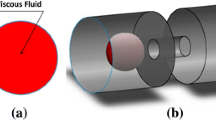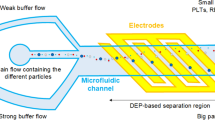Abstract
Circulating tumor cell (CTC) isolation has made positive impacts on metastatic detection and therapy analysis for cancer patients. Microfluidic-elasto-filtration (MEF) device based on the critical elasto-capillary number (Ca * e ) has been proposed to utilize the optimal multi-parameter conditions, including cell diameter (dc), the diameter of cylindrical filter pores (dp), nonlinear cell elasticity and hydrodynamic drag force, for selectively capturing CTCs and depleting white blood cells (WBCs). In this paper, we propose a novel two-degree-of-freedom nonlinear mass–damper–spring (m–c–k) model to predict the dynamic behaviors of CTCs and WBCs in a generic MEF device. This model enables the optimization of the device design to achieve extremely high CTC capture efficiency and WBC depletion efficiency. In particular, the function of nonlinear cell stiffness specific to different cell types and MEF’s pore diameters is first determined by finite element method with neo-Hookean hyperelastic model, based on which the mechanical behaviors of CTCs and WBCs in MEF devices are systematically studied. Herein, the predicted normalized deformations of a CTC and WBC as a function of Cae are used to determine the optimized Cae of 0.043, consistent with the experimental results from the fabricated MEF devices using MCF-7 cells (0.04 ± 0.006). In addition, the normalized cell diameter versus Cae phase diagram is proposed for the first time as a useful tool for design optimization of MEF devices and other microfiltration devices.







Similar content being viewed by others

References
Adams DL et al (2014) The systematic study of circulating tumor cell isolation using lithographic microfilters. RSC Adv 9:4334–4342. https://doi.org/10.1039/C3RA46839A
Aghaamoo M, Zhang Z, Chen X, Xu J (2015) Deformability-based circulating tumor cell separation with conical-shaped microfilters: concept, optimization, and design criteria. Biomicrofluidics 9:034106. https://doi.org/10.1063/1.4922081
Alix-Panabieres C, Pantel K (2013) Circulating tumor cells: liquid biopsy of cancer. Clin Chem 59:110–118. https://doi.org/10.1373/clinchem.2012.194258
Bain BJ (2006) Blood cells: a practical guide, 4th edn. Blackwell Publishing Asia Pty Ltd., Australia
Caille N, Thoumine O, Tardy Y, Meister J-J (2002) Contribution of the nucleus to the mechanical properties of endothelial cells. J Biomech 35:177–187. https://doi.org/10.1016/S0021-9290(01)00201-9
Carpenter A et al (2006) Cell profiler: image analysis software for identifying and quantifying cell phenotypes. Genome Biol 7:R100
Chang H, Zhou P, Xie Z, Gong X, Yang Y, Yuan W (2013) Theoretical modeling for a six-DOF vortex inertial sensor and experimental verification. J Microelectromech Syst 22:1100–1108
Chen J (2014) Nanobiomechanics of living cells: a review. Interface Focus 4:20130055
Chen M, Boyle FJ (2014) Investigation of membrane mechanics using spring networks: application to red-blood-cell modelling. Mater Sci Eng C 43:506–516. https://doi.org/10.1016/j.msec.2014.07.043
Chen C-L et al (2013) Single-cell analysis of circulating tumor cells identifies cumulative expression patterns of EMT-related genes in metastatic prostate cancer. Prostate 73:813–826. https://doi.org/10.1002/pros.22625
Cong Z et al (2015) The capillary number effect on the capture efficiency of cancer cells on composite microfluidic filtration chips. In: Micro electro mechanical systems (MEMS), 2015 28th IEEE international conference on, 18–22 January 2015, pp 459–462. https://doi.org/10.1109/memsys.2015.7050989
Cong Z et al (2016) Capillary number effect on the depletion of leucocytes of blood in microfiltration chips for the isolation of circulating tumor cells. In: Proceedings of the 11th annual IEEE international conference on nano/micro engineered and molecular systems (IEEE-NEMS 2016), Matsushima Bay and Sendai MEMS City, Japan, p 1
Corbin EA, Kong F, Lim CT, King WP, Bashir R (2015) Biophysical properties of human breast cancer cells measured using silicon MEMS resonators and atomic force microscopy. Lab Chip 15:839–847. https://doi.org/10.1039/C4LC01179A
Coumans FAW, van Dalum G, Beck M, Terstappen LWMM (2013) Filtration parameters influencing circulating tumor cell enrichment from whole blood. PLoS One 8:e61774. https://doi.org/10.1371/journal.pone.0061774
Cross SE, Jin Y-S, Rao J, Gimzewski JK (2007) Nanomechanical analysis of cells from cancer patients. Nat Nano 2:780–783
Dao M, Lim CT, Suresh S (2003) Mechanics of the human red blood cell deformed by optical tweezers. J Mech Phys Solids 51:2259–2280. https://doi.org/10.1016/j.jmps.2003.09.019
Desitter I et al (2011) A new device for rapid isolation by size and characterization of rare circulating tumor cells. Anticancer Res 31:427–441
Ding Y, Xu G-K, Wang G-F (2017) On the determination of elastic moduli of cells by AFM based indentation. Sci Rep 7:45575. https://doi.org/10.1038/srep45575
Estridge BH, Reynolds AP, Walters NJ (2000) Basic medical laboratory techniques. Delmar Cengage Learning, Albany, NY
Grover WH, Bryan AK, Diez-Silva M, Suresh S, Higgins JM, Manalis SR (2011) Measuring single-cell density. PNAS 108:10992–10996. https://doi.org/10.1073/pnas.1104651108
Harouaka RA, Nisic M, Zheng S-Y (2013) Circulating tumor cell enrichment based on physical properties. JALA 18:455–468. https://doi.org/10.1177/2211068213494391
Harouaka RA et al (2014) Flexible micro spring array device for high-throughput enrichment of viable circulating tumor cells. Clin Chem 60:323–333. https://doi.org/10.1373/clinchem.2013.206805
Hochmuth RM, Ting-Beall HP, Beaty BB, Needham D, Tran-Son-Tay R (1993) Viscosity of passive human neutrophils undergoing small deformations. Biophys J 64:1596–1601
Hosokawa M, Hayata T, Fukuda Y, Arakaki A, Yoshino T, Tanaka T, Matsunaga T (2010) Size-selective microcavity array for rapid and efficient detection of circulating tumor cells. Anal Chem 82:6629–6635. https://doi.org/10.1021/ac101222x
Kaiser J (2010) Cancer’s circulation problem. Science 327:1072–1074. https://doi.org/10.1126/science.327.5969.1072
Kim J-D, Waleed M, Lee Y-G (2013) Stiffness measurement of a biomaterial by optical manipulation of microparticle. In: Proceedings of SPIE 8595: 85951G. https://doi.org/10.1117/12.2005544
Kuznetsova TG, Starodubtseva MN, Yegorenkov NI, Chizhik SA, Zhdanov RI (2007) Atomic force microscopy probing of cell elasticity. Micron 38:824–833. https://doi.org/10.1016/j.micron.2007.06.011
Lee SS, Antaki JF, Kameneva MV, Dobbe JG, Hardeman MR, Ahn KH, Lee SJ (2007) Strain hardening of red blood cells by accumulated cyclic supraphysiological stress. Artif Organs 31:80–86. https://doi.org/10.1111/j.1525-1594.2007.00344.x
Lee HJ et al (2013) Efficient isolation and accurate in situ analysis of circulating tumor cells using detachable beads and a high-pore-density filter. Angew Chem Int Ed 52:8337–8340. https://doi.org/10.1002/anie.201302278
Li QS, Lee GYH, Ong CN, Lim CT (2008) AFM indentation study of breast cancer cells. BBRC 374:609–613. https://doi.org/10.1016/j.bbrc.2008.07.078
Lim C, Zhou E, Quek S (2006) Mechanical models for living cells—a review. J Biomech 39:195–216
Lim LS et al (2012) Microsieve lab-chip device for rapid enumeration and fluorescence in situ hybridization of circulating tumor cells. Lab Chip 12:4388–4396. https://doi.org/10.1039/C2LC20750H
Luo Y et al (2014) A constriction channel based microfluidic system enabling continuous characterization of cellular instantaneous Young’s modulus. Sens Actuators B Chem 202:1183–1189
McFaul SM, Lin BK, Ma H (2012) Cell separation based on size and deformability using microfluidic funnel ratchets. Lab Chip 12:2369–2376. https://doi.org/10.1039/C2LC21045B
Milovanovic L, Ma H (2012) Method for measurement of friction forces on single cells in microfluidic devices. Anal Methods 4:4303–4309. https://doi.org/10.1039/C2AY25740H
Munson BR, Young DF, Okiishi TH, Huebsch WW (2006) Fundamentals of fluid mechanics, vol 69. Wiley, Hoboken, p 520
Park K et al (2010) Measurement of adherent cell mass and growth. PNAS 107:20691–20696. https://doi.org/10.1073/pnas.1011365107
Peeters EAG, Oomens CWJ, Bouten CVC, Bader DL, Baaijens FPT (2005) Mechanical and failure properties of single attached cells under compression. J Biomech 38:1685–1693. https://doi.org/10.1016/j.jbiomech.2004.07.018
Rodriguez ML, McGarry PJ, Sniadecki NJ (2013) Review on cell mechanics: experimental and modeling approaches. Appl Mech Rev 65:060801
Sajeesh P, Raj A, Doble M, Sen AK (2016) Characterization and sorting of cells based on stiffness contrast in a microfluidic channel. RSC Adv 6:74704–74714. https://doi.org/10.1039/C6RA09099K
Soloukhin VA, Brokken-Zijp JCM, van Asselen OLJ, de With G (2003) Physical aging of polycarbonate: elastic modulus, hardness, creep, endothermic peak, molecular weight distribution, and infrared data. Macromolecules 36:7585–7597. https://doi.org/10.1021/ma0342980
Tang Y, Shi J, Li S, Wang L, Cayre YE, Chen Y (2014) Microfluidic device with integrated microfilter of conical-shaped holes for high efficiency and high purity capture of circulating tumor cells. Sci Rep 4:6052. https://doi.org/10.1038/srep06052
Vaidyanathan R, Soon RH, Zhang P, Jiang K, Lim CT (2019) Cancer diagnosis: from tumor to liquid biopsy and beyond. Lab Chip 19:11–34. https://doi.org/10.1039/C8LC00684A
Vona G et al (2000) Isolation by size of epithelial tumor cells: a new method for the immunomorphological and molecular characterization of circulating tumor cells. Am J Pathol 156:57–63
White FM, Corfield I (2006) Viscous fluid flow, vol 3. McGraw-Hill, New York
Wicha M, Hayes D (2011) Circulating tumor cells: not all detected cells are bad and not all bad cells are detected. J Clin Oncol 29:1508–1511
Xu G, Shao J-Y (2008) Human neutrophil surface protrusion under a point load: location independence and viscoelasticity. Am J Physiol Cell Physiol 295:C1434–C1444. https://doi.org/10.1152/ajpcell.00136.2008
Ye S, Ng Y, Tan J, Leo H, Kim S (2014) Two-dimensional strain-hardening membrane model for large deformation behavior of multiple red blood cells in high shear conditions. Theor Biol Med Model 11:19
Zhang Z, Xu J, Hong B, Chen X (2014) The effects of 3D channel geometry on CTC passing pressure—towards deformability-based cancer cell separation. Lab Chip. https://doi.org/10.1039/c4lc00301b
Zhang Z, Chen X, Xu J (2015) Entry effects of droplet in a micro confinement: implications for deformation-based circulating tumor cell microfiltration. Biomicrofluidics 9:024108. https://doi.org/10.1063/1.4916645
Zheng S, Lin H, Liu JQ, Balic M, Datar R, Cote RJ, Tai YC (2007) Membrane microfilter device for selective capture, electrolysis and genomic analysis of human circulating tumor cells. J Chromatogr A 1162:154–161
Zhou EH, Lim CT, Quek ST (2005) Finite element simulation of the micropipette aspiration of a living cell undergoing large viscoelastic deformation. Mech Adv Mater Struct 12:501–512. https://doi.org/10.1080/15376490500259335
Acknowledgements
The authors would like to acknowledge the support of a Grant from HKUST-BME Division, the Grants from NSFC (nos. 81372274, 8141101080 and 11702236), Guangzhou Science and Technology Innovation Commission (no. 201704030101), Guangdong Science and Technology Grant (no. 2017B050506001) and Hong Kong ITF Grant (no. GHP/076/17GD).
Author information
Authors and Affiliations
Corresponding author
Additional information
Publisher's Note
Springer Nature remains neutral with regard to jurisdictional claims in published maps and institutional affiliations.
Electronic supplementary material
Below is the link to the electronic supplementary material.
Rights and permissions
About this article
Cite this article
Luo, H., Zhao, C., Song, K. et al. A nonlinear two-degree-of-freedom mass–damper–spring model to predict the isolation of circulating tumor cells in microfluidic-elasto-filtration devices. Microfluid Nanofluid 23, 72 (2019). https://doi.org/10.1007/s10404-019-2240-z
Received:
Accepted:
Published:
DOI: https://doi.org/10.1007/s10404-019-2240-z



